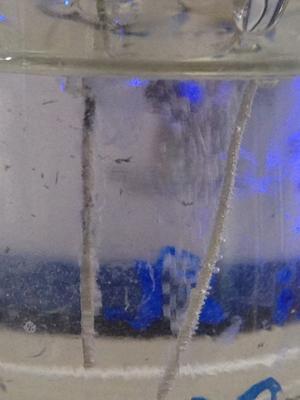 Sphere Within Sphere by Arnaldo Pomodoro in Trinity College Dublin. (Credit: Flickr @ William Murphy http://www.flickr.com/photos/infomatique/)
Sphere Within Sphere by Arnaldo Pomodoro in Trinity College Dublin. (Credit: Flickr @ William Murphy http://www.flickr.com/photos/infomatique/)Researchers at CRANN, Ireland’s first purpose-built research institute whose purpose is to perform nanoscience research, based at Trinity College Dublin (TCD), have developed a new method of splitting water into hydrogen and oxygen. The discovery will have significant impact in the worldwide race to cheaply and efficiently produce hydrogen gas, hailed as the clean energy source of the future.

Water splitting in action: oxygen evolving on right hand nickel oxide electrode, hydrogen evolving at left hand electrode. (Credit: Trinity College Dublin)
Professor Mike Lyons, a Principal Investigator at CRANN and TCD’s School of Chemistry and his team have developed new inexpensive materials based on iron and nickel oxide to split water into its components hydrogen and oxygen (water electrolysis). These materials are much cheaper, more readily available and more efficient than those used in current electrolysis methods.
Hydrogen gas has been identified as the alternative energy source of the future. However, its production using steam reforming of natural gas is still relatively difficult and unsustainable. In contrast, hydrogen generation by water electrolysis provides a reliable, environmentally friendly method of large-scale production. CRANN’s methods are the first inexpensive and efficient methods of water electrolysis to be identified worldwide.
The research has spurred international interest and recently received Hot Article Status in the leading chemistry journal Physical Chemistry Chemical Physics (PCCP). Hot article Status is given to articles of high impact and extraordinarily high quality.
Professor John Boland Director of CRANN said, “Nanoscience is vastly improving a number of industries from medicine, to technology to energy production. Whether it is in lightweight coatings for wind turbines, or new sensors for solar panels, our methods continue to assist in the move to sustainable, alternative and clean energy supply. Professor Lyons’ method of splitting water is a world first. It truly has the potential to revolutionize the production of hydrogen gas and bring it one step closer as a realistic energy alternative.”
Professor Mark Ferguson Director General of Science Foundation Ireland said “I congratulate Professor Lyons and his team on this research advance and for the international recognition it has achieved. This is a good example of SFIs goal of funding internationally competitive, excellent science with potential economic, environmental and societal impact.”
Commenting, Professor Lyons said, “With my team of researchers, we are consistently striving to use well-known research methods to deliver unprecedented results. This method of water electrolysis takes the simplest of materials—nickel and iron—and uses them to ground-breaking effect. Hydrogen is the next clean energy source and CRANN is leading the international race to find its best method of production.”
Doyle RL, Godwin IJ, Brandon MP, & Lyons ME (2013). Redox and electrochemical water splitting catalytic properties of hydrated metal oxide modified electrodes. Physical chemistry chemical physics : PCCP PMID: 23652494
